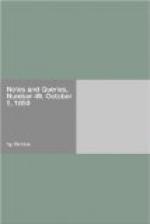Who was Arthur Moore, Esq.? and who was the “giddy son?” Was the latter James Moore Smith a gentleman whose family name was, I think, Moore, and who assumed (perhaps for a fortune) the additional name of Smith? This gentleman Pope seems to call indiscriminately Moore, Moor, and More: and when he says that his good nature towards the dunces was so great that he had even “rhymed for Moor” (Ib. v. 373.), I cannot but suspect that the Moor for whom he had rhymed, was the giddy son whom Arthur accused him of seducing from the law to the Muses. There are many allusions to this Mr. James Moore Smith throughout Pope’s satirical works, but all very obscure; and Warburton, though he appears to have known him, affords no explanation as to who or what he was. He was the author of a comedy called The Rival Modes.
C.
Dr. E. Cleaver, Bishop of Cork.—I shall feel much obliged to any of your correspondents who will furnish me with the particulars of the consecration of Dr. Euseby Cleaver to the sees of Cork and Ross, in March, April, or May, 1789. Finding no record of the transaction in the Diocesan Registry of Cork, and not being able to trace it in any other part of Ireland, I am induced to believe that this consecration may have taken place in England; and shall be very glad to be correctly informed upon the point.
H. COTTON.
Thurles, Ireland.
Gwynn’s London and Westminster.—Mr. Thomas Frederick Hunt, in his Exemplars of Tudor Architecture, 4to. London, 1830, in a note at p. 23., alludes to London and Westminster improved, by John Gywnn, London, 1766, 4to., and has this remark:
“It is a singular fact, that in this work John Gwynn pointed out almost all the designs for the improvement of London, which have been devised by the civil and military architects of the present day.”
And Mr. Hunt concludes by observing,, that—
“This discovery was made by the Literary Gazette.”
Will you permit me, through the medium of your useful publication, to solicit information of the number and date of the Literary Gazette which recalled public attention to this very remarkable fact?
Sec.N.
Coronet.—In Newbold Church, in the county of Warwick, is a monument to the memory of Thomas Boughton of Lawford, and Elizabeth his wife, representing him in a suit of armour, with sword and spurs, a coronet on his head, and a bear at his feet, chained and muzzled. Query.—Can any of your readers give an accurate description of this coronet? Or can any of them mention instances of the monuments of esquires having similar coronets? The date of his death is not given: his wife died in the year 1454.
Z.




